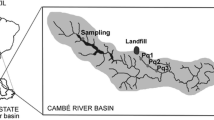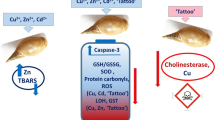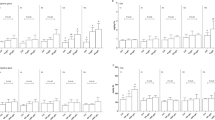Abstract
This study evaluated the alteration of the enzymatic system of the freshwater Asian clam exposed to different copper concentrations. Individuals of Corbicula fluminea were exposed to different concentrations of dissolved Cu (0.5, 1, and 2 mg L−1) for 7 days, then, biomarkers of oxidative stress (GST, GPx, GR), exposure (MTs), effect (AChE), and damage (LPO, DNA strand breaks) were quantified. Results showed positive correlations between dissolved metal concentrations and GPx, MTs, and DNA damage, and negative correlation with GST and AChE. In contrast, no clear trend was found for GR and LPO. In general, the established mechanisms of protection might have a beneficial effect on the decreasing ROS attack on membrane and the activation of the metallothioneins. Integrated biomarker analysis revealed that the measured alterations are well correlated with the levels of increasing dissolved copper concentrations in water, demonstrating the effectiveness of this organism for biomonitoring approach purposes.


Similar content being viewed by others
References
Abessa DMS, Gonçalves L, Fernando C, Davanso MB, Guimarães V et al (2014) Sediment geochemistry and climatic influences in a river influenced by former mining activities: the case of Ribeira de Iguape River, SP-PR, Brazil. Open J Water Pollut Treat 1:43–54
Bagchi D, Bagchi M, Hassoun EA, Stohs SJ (1995) In vitro and in vivo generation of reactive oxygen species, DNA damage and lactate dehydrogenase leakage by selected pesticides. Toxicology 104:129–140
Barka S, Pavillon JF, Amiard JC (2001) Influence of different essential and non- essential metals on MTLP levels in the copepod Tigriopus brevicornis. Comp Biochem Physiol C 128:479–493
Bayne BL, Brown DA, Burns K, Dixon DP, Ivanovici A, Livingstone DR, Lowe DM et al (1985) The effects of stress and pollution on marine animals. Praeger Scientific, New York
Beliaeff B, Burgeot T (2002) Integrated biomarker response: a useful tool for ecological risk assessment. Environ Toxicol Chem 21(6):1316–1322
Bocquené G, Galgani F, Truquet P (1990) Characterization and assay conditions for use of AChE activity from several marine species in pollution monitoring. Mar Environ Res 30:75–89
Bonnail E, Sarmiento AM, DelValls TA, Nieto JM, Riba I (2016) Assessment of metal contamination, bioavailability, toxicity and bioaccumulation in extreme metallic environments (Iberian Pyrite Belt) using Corbicula fluminea. Sci Total Environ 544:1031–1044
Bradford MM (1976) A rapid and sensitive method for the quantitation of microgram quantities of protein utilizing the principle of protein–dye binding. Anal Biochem 2:248–254
Capdevila M, Bofill R, Palacio O, Atrian S (2012) State-of-the-art of metallothioneins at the beginning of the 21st centuruy. Coord Chem Rev 256:46–62
CONAMA 357/2005. Resoluçao N257, de 17 de Março de 2005. http://www.mma.gov.br/port/conama/res/res05/res35705.pdf
Depledge MH (1994) The rational basis for use of biomarkers as ecotoxicological tools. In: Fossi MC, Leonzio C (eds) Nondestructive biomarkers in vertebrates. Lewis Publishers, Boca Raton, pp 271–295
Directive 2000/60/EC of the European Parliament and of the Council establishing a framework for the Community action in the field of water policy. http://ec.europa.eu/environment/water/water-framework/index_en.html
Doyotte A, Cossu C, Jacquin MC, Babut M, Vasseur P (1997) Antioxidant enzymes, glutathione and lipid peroxidation as relevant biomarkers of experimental or field exposure in the gills and the digestive gland of the freshwater bivalve Unio tumidus. Aquat Toxicol 39(2):93–110
Ellman GL, Courtney D, Andres JV, Feathersthone RM (1961) A new and rapid colorimetric determination of acetylcholinesterase activity. Biochem Pharmacol 7:88–96
Franco R, Sánchez-Olea R, Reyes-Reyes EM, Panayiotidis MI (2009) Environmental toxicity, oxidative stress and apoptosis: ménage à trois. Mutat Res 674:3–22
Frasco MF, Fournier D, Carvalho F, Guilhermino L (2005) Do metals inhibit acetylcholinesterase (AChE)? Implementation of assay conditions for the use of AChE activity as a biomarker of metal toxicity. Biomarkers 10(5):360–375
Frausto da Silva JJR, Williams JP (2001) Copper: extracytoplasmic oxidases and matrix formation. In: Silva JJR, Williams JP (eds) The biological chemistry of the element, 2nd edn. Oxford University Press, Oxford
Gaetke LM, Chow K (2003) Copper toxicity, oxidative stress, and antioxidant nutrients. Toxicology 189:147–163
Graney RL, Donald JS, Cairns CJ Jr (1983) Heavy metal indicator potential of the Asiatic clam (Corbicula fluminea) in artificial stream systems. Hydrobiologia 102:81–88
Huggett JR, Kimerle RA, Mehrle PM, Bergman HL (1992) Biomarkers, biochemical, physiological, and histological markers and anthropogenic stress. Lewis, Boca Raton, p 347
Key PB, Fulton MH (2002) Characterization of cholinesterase activity in tissues of the grass shrimp (Palaemonetes pugio). Pestic Biochem Physiol 72:186–192
Kopecka-Pilarczyk J (2010) The effect of pesticides and metals on acetylcholinesterase (AChE) in various tissues of blue mussel (Mytilus trossulus L.) in short-term in vivo exposures at different temperatures. J Environ Sci Health B 45:336–346
Luza SC, Speisky HC (1996) Liver copper storage and transport during development: implications for cytotoxicity. Am J Clin Nutr 63:812S–820S
Marie V, Baudrimont M, Boudou A (2006) Cadmium and zinc bioaccumulation and metallothionein response in two freshwater bivalves (Corbicula fluminea and Dreissena polymorpha) transplanted along a polymetallic gradient. Chemosphere 65:609–617
Martín-Díaz ML, Blasco J, Sales D, DelValls TA (2009) The use of a kinetic biomarker approach for in situ monitoring of littoral sediments using the crab Carcinus maenas. Mar Environ Res 68(2):82–88
Mason AZ, Jenkins KD (1995) Metal detoxification in aquatic organisms. In: Tessier A, Turner DR (eds) Metal speciation and bioavailability in aquatic systems. Wiley, Chichester, p 679
McFarland VA, Inouye SL, Lutz CH, Jarvis AS, Clarke JU, McCant DD (1999) Biomarkers of oxidative stress and genotoxicity in livers of field collected brown bullhead, Ameiurus nebulosus. Arch Environ Contam Toxicol 37:236–241
Meagher EA, Fitzgerald GA (2000) Indices of lipid peroxidation in vivo: strengths and limitations. Free Radic Biol Med 28:1745–1750
Mora P, Fournier D, Narbonne JF (1999) Cholinesterases from the marine mussels Mytilus galloprovincialis Lmk. and Mytillus edulis from the freshwater bivalve Corbicula fluminea Müller. Comp Biochem Physiol C 122:353–361
Morais LG, Perina FC, Davanso MB, Buruaem LM, Rodrigues VGS, Sígolo JB, Abessa DMS (2013) Water and sediment ecotoxicological assessment in a river affected by former mining activities. Pan-Am J Aquat Sci 8(4):327–338
Olive PL (1988) DNA precipitation assay: a rapid and simple method for detecting DNA damage in mammalian cells. Environ Mol Mutagen 11:487–495
Oliveira LF, Silva SMCP, Martinez CBR (2014) Assessment of domestic landfill leachate toxicity to the Asian clam Corbicula fluminea via biomarkers. Ecotoxiol Environ Safe 103:17–23
Paekeall DB, Shugart RL (1993) Research and application in the assessment of environmental health. In: Paekall DB, Shugart RL (eds) Biomarkers: research and application in the assessment of environmental health. NATO ASI Series—Series H: Cell Biology 68. NATO, Texel
Ringwood AH, Conners DE (2000) The effects of glutathione depletion on reproductive success in oysters, Crassostrea virginica. Mar Environ Res 50:207–211
Roesijadi G, Robinson WE (1994) Metal regulation in aquatic animals: mechanisms of uptake, accumulation and release. In: Malins DC, Ostrander GK (eds) Aquatic toxicology; molecular biochemical and cellular perspectives. CRC Press, Boca Raton
Sánchez W, Burgeot T, Porcher JM (2013) A novel “Integrated Biomarker Response” calculation based on reference deviation concept. Environ Sci Pollut R 20(5):2721–2725
Stagg RM (1998) The development of an international programme for monitoring the biological effects of contaminants in the OSPAR convention area. Mar Environ Res 46:307–313
Stohs SJ, Bagchi D (1995) Oxidative mechanisms in the toxicity of metal-ions. Free Radic Biol Med 18:321–336
Tsarpali V, Dailianis S (2012) Investigation of landfill leachate toxic potency: an integrated approach with the use of stress indices in tissue of mussels. Aquat Toxicol 124–125:58–65
Valavanidis A, Vlahogianni T, Dassenakis M, Scoullos M (2006) Molecular biomarkers of oxidative stress in aquatic organisms in relation to toxic environmental pollutants. Ecotoxicol Environ Safe 64:178–189
van der Oost R, Beyer J, Vermeulen NPE (2003) Fish bioaccumulation and biomarkers in environmental risk assessment: a review. Environ Toxicol Pharmacol 13:57–149
Viarengo A, Nott JA (1993) Mechanisms of heavy metal cation homeostasis in marine invertebrates. Comp Biochem Phys C 104:355–372
Viarengo A, Canesi L, Pertica M, Poli G, Moore MN, Orunesu M (1990) Heavy metal effects on lipid peroxidation in the tissues of Mytilus galloprovincialis Lam. Comp Biochem Physiol 97C:37–42
Viarengo A, Ponzano E, Dondero F, Fabbri E (1997) A simple spectrophotometric method for metallothionein evaluation in marine organisms: an application to Mediterranean and Antartic mollusks. Mar Environ Res 44:69–84
Viarengo A, Lowe D, Bolognesi C, Fabbri E, Koehler A (2007) The use of biomarkers in biomonitoring: a 2-tier approach assessing the level of pollutant-induced stress syndrome in sentinel organisms. Comp Biochem Phys Part C 146:281–300
Wills ED (1987) Evaluation of lipid peroxidation in lipids and biological membranes. In: Mullock B, Snell K (ed) Biochemical toxicology a practical approach. IRL Press, Oxford, pp 127–150
Acknowledgments
The first author thanks the International Grant from Bank Santander/UNESCO Chair UNITWIN/WiCop and the Erasmus Mundus Programme for the MACOMA Doctoral funding contract (SGA 2012-1701/001-001-EMJD). We thank the Brazilian National Council for Scientific and Technological Development (CNPq; Grant #479899/2013-4), the São Paulo Research Foundation (FAPESP, Grant #2009/52762-6), and the Brazilian Aquatic Research Foundation (FUNDESPA) for the financial support. Dr. Lucas Buruaem thanks FAPESP (Grant #2013/15482-0, São Paulo Research Foundation) and Dr. Abessa thanks CNPq (Grants 308649/2011-7 and 311609/2014-7). The authors thank Dr. Van Den Brink and the reviewers for their expert guidance that has contributed to the improvement of the manuscript and R. Ojeda for the English language review.
Author information
Authors and Affiliations
Corresponding author
Rights and permissions
About this article
Cite this article
Bonnail, E., Buruaem, L.M., Araujo, G.S. et al. Multiple Biomarker Responses in Corbicula fluminea Exposed to Copper in Laboratory Toxicity Tests. Arch Environ Contam Toxicol 71, 278–285 (2016). https://doi.org/10.1007/s00244-016-0281-9
Received:
Accepted:
Published:
Issue Date:
DOI: https://doi.org/10.1007/s00244-016-0281-9




